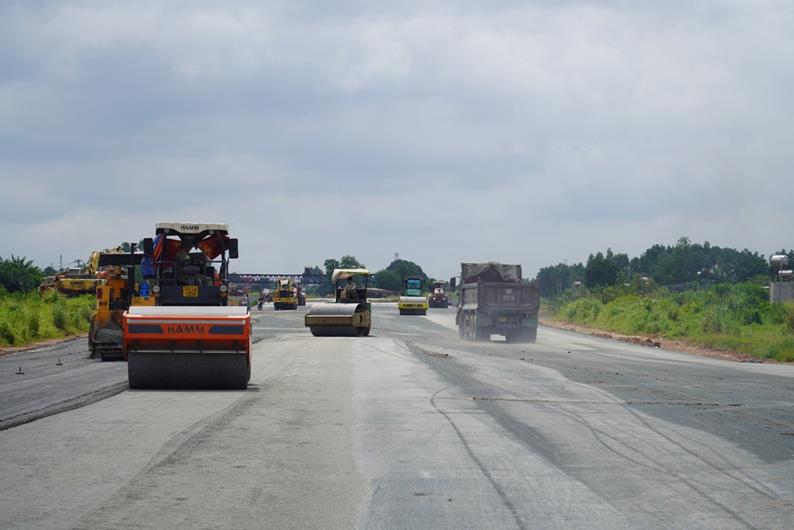(News Portal – Dong Nai) - Investing in the completion of transport infrastructure system to generate driving force for development is the top priority of the Southeast Region.

Construction of the Ben Luc - Long Thanh expressway project passing through the province.
Waiting for "boulevards" of development
Bien Hoa - Vung Tau Expressway phase 1 and Beltway 3 - Ho Chi Minh City are important traffic routes of the Southeast region according to planning. Since mid-June, both of these important transportation infrastructure projects has been constructed.
Bien Hoa - Vung Tau expressway is a route that will connect two dynamically developing localities of the Southeast region, Dong Nai and Ba Ria - Vung Tau. In the future, this will also be the main connecting axis between Long Thanh International Airport and Cai Mep - Thi Vai seaport cluster. However, because this expressway is also connected to the Ho Chi Minh City - Long Thanh - Dau Giay expressway, when completed and put into operation, it will create the "quadrangle" of the four most developed localities in the Southeast region, which are Ho Chi Minh City, Binh Duong, Dong Nai and Ba Ria - Vung Tau provinces.
Meanwhile, the Beltway 3 - Ho Chi Minh City project not only plays a role in connecting the Southeast region when passing through Ho Chi Minh City, Binh Duong, and Dong Nai provinces, but it is also serve as a connecting route between the Southeast region and the Mekong Delta as the project's endpoint is located in Long An province.
According to Acting Chairman of the Provincial People's Committee Vo Tan Duc, the projects of Bien Hoa - Vung Tau expressway phase 1 and Beltway 3 - Ho Chi Minh City, when completed and put into operation, will not only open up new opportunities for the province's development, but also for the Southeast region.
Previously to these projects, other transport infrastructure projects connecting the Southeast region were also implemented such as Ben Luc - Long Thanh expressway, Long Thanh airport, and the expansion of Tan Son Nhat airport.
At the end of August, speaking at the groundbreaking ceremony of 3 bidding investment packages to build Long Thanh airport phase 1 and expand Tan Son Nhat airport, Prime Minister Pham Minh Chinh assessed that these were two particularly major projects, playing a vital role in the national airport network, belonging to important projects related to national defense and security, as well as socio-economic development of the key economic sector in the South in particular and the country in general. “Once completed, these two projects will contribute in making Vietnam a major transportation hub in the region and the world. Furthermore, they will open up new development space for the aviation economic ecosystem, create new growth drivers, promote development and improve national competitiveness" - Prime Minister Pham Minh Chinh emphasized.
Mobilize resources to build regional transport networks
In addition to the above projects, according to the plan to complete the transportation infrastructure network connecting the Southeast region, a number of projects will be implemented. As a result, resource mobilization is forecasted to be huge in order to implement these projects, which itself is a "problem" that needs to be solved soon.
At the first conference of the Southeast Region Coordinating Council in mid-July, Minister of Transport Nguyen Van Thang pointed out key tasks and solutions for investment in construction and completion of transportation infrastructure network connecting the region. The Minister emphasized researching and proposing specific groundbreaking mechanisms and policies to push the development of the Southeast region and promote regional connectivity similar to some other Ho Chi Minh City's pilot mechanisms and policies has been approved by the National Assembly. These trial mechanisms and policies focus on thoroughly decentralizing power to localities with capacity and experience in implementing inter-regional infrastructure investment to proactively mobilize and utilize local resources, along with strengthening inspection, supervision and appropriate resource allocation.
At the same time, new mechanisms and policies should be developed to increase the attractiveness and investment efficiency of projects in the form of public-private partnerships (PPP) such as: increasing the proportion of state capital participating in the project; effectively exploiting resources from infrastructure assets (such as concessions to exploit existing transport infrastructure), building incentive mechanisms to attract strategic investors...; research and implement a mechanism to create a land fund to auction and select investors for urban development, trade and service investment projects on both sides of the expressway, and stations of the metro going through urban areas associated with the transit-oriented development (TOD) model.
The Minister also suggested that localities in the region needed to proactively devote resources in investing, completing, and promptly upgrading and synchronously connecting routes from highways and main traffic routes to economic zones, industrial zones, seaports, airports and inland waterway ports, to ensure synchronous exploitation of transport infrastructure, without wasting any resources.
Previously, at the second exchange and cooperation conference between Ho Chi Minh City and the Southeast provinces held in early July, the Ho Chi Minh City Institute for Development Studies also proposed two options for establishing infrastructure development fund for the Southeast region.
According to the Provincial People's Committee, having a common infrastructure investment fund for the entire region with an open mechanism will promote the development process and connect localities in the region.